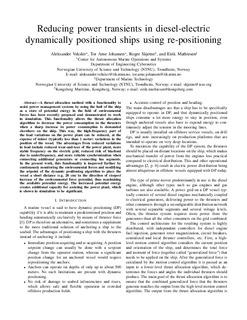| dc.contributor.author | Veksler, Aleksander Vladimirovitsj | |
| dc.contributor.author | Johansen, Tor Arne | |
| dc.contributor.author | Skjetne, Roger | |
| dc.contributor.author | Mathiesen, Eirik | |
| dc.date.accessioned | 2014-12-15T02:36:03Z | |
| dc.date.accessioned | 2016-06-20T11:12:03Z | |
| dc.date.available | 2014-12-15T02:36:03Z | |
| dc.date.available | 2016-06-20T11:12:03Z | |
| dc.date.issued | 2014 | |
| dc.identifier.citation | IEEE Industrial Electronics Society. Annual Conference. Proceedings 2014 | nb_NO |
| dc.identifier.issn | 1553-572X | |
| dc.identifier.uri | http://hdl.handle.net/11250/2393227 | |
| dc.description.abstract | A thrust allocation method with a functionality to assist power management systems by using the hull of the ship as a store of potential energy in the field of environmental forces has been recently proposed and demonstrated to work in simulation. This functionality allows the thrust allocation algorithm to decrease the power consumption in the thrusters when a sharp increase in power consumption is demanded elsewhere on the ship. This way, the high-frequency part of the load variations on the power plant can be reduced, at the expense of minor (typically less than 1 meter) variations in the position of the vessel. The advantages from reduced variations in load include reduced wear-and-tear of the power plant, more stable frequency on the electric grid, reduced risk of blackout due to underfrequency, and more reliable synchronization when connecting additional generators or connecting bus segments. In the present work, this functionality is improved further by continuously monitoring the environmental forces and modifying the setpoint of the dynamic positioning algorithm to place the vessel a short distance (e.g. 20 cm) in the direction of steepest increase of the environmental force potential, thus maximizing the available potential energy. The increased potential energy creates additional capacity for assisting the power plant, which is shown in simulation to be significant. | nb_NO |
| dc.language.iso | eng | nb_NO |
| dc.publisher | IEEE | nb_NO |
| dc.title | Reducing power transients in diesel-electric dynamically positioned ships using re-positioning | nb_NO |
| dc.type | Journal article | nb_NO |
| dc.date.updated | 2014-12-15T02:36:04Z | |
| dc.description.version | submittedVersion | |
| dc.source.pagenumber | 268 - 273 | nb_NO |
| dc.identifier.doi | 10.1109/IECON.2014.7048510 | |
| dc.identifier.cristin | 1150926 | |
| dc.description.localcode | Preprint version. © IEEE. Personal use of this material is permitted. Permission from IEEE must be obtained for all other users, including reprinting/ republishing this material for advertising or promotional purposes, creating new collective works for resale or redistribution to servers or lists, or reuse of any copyrighted components of this work in other works. | nb_NO |
